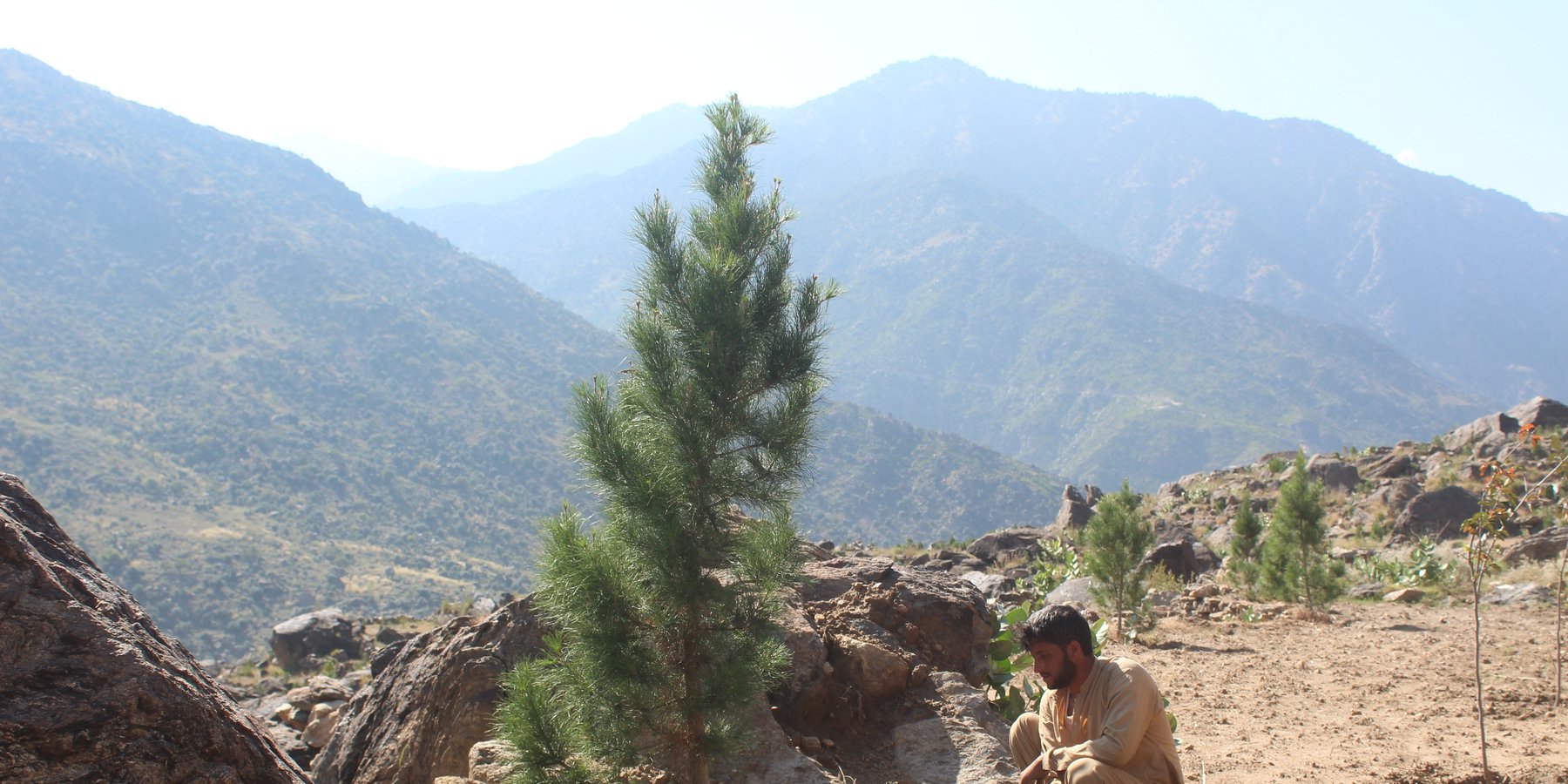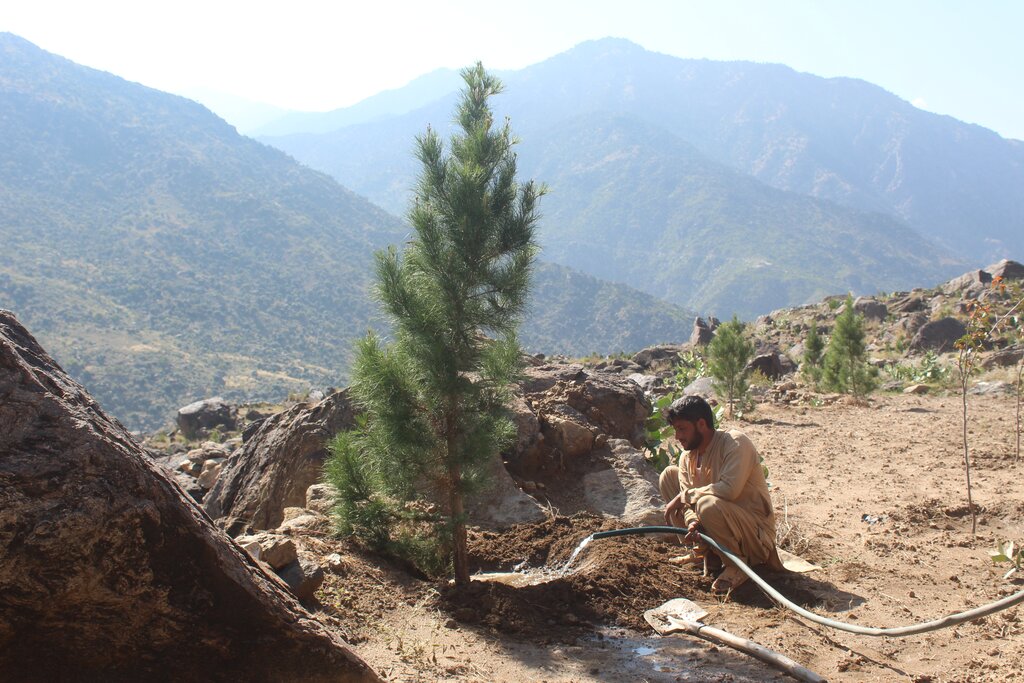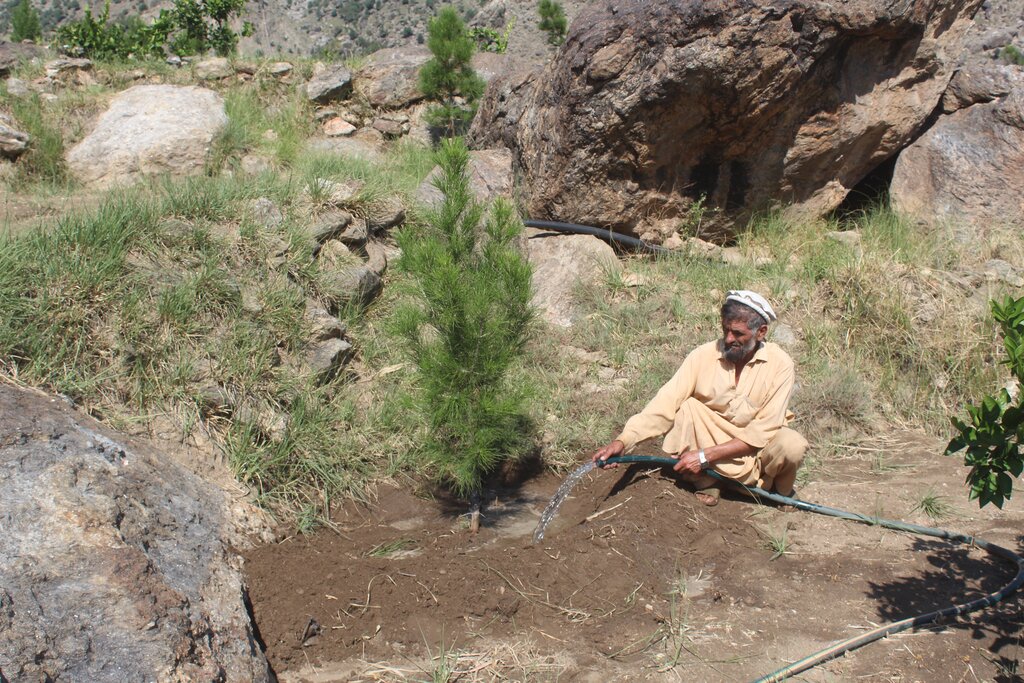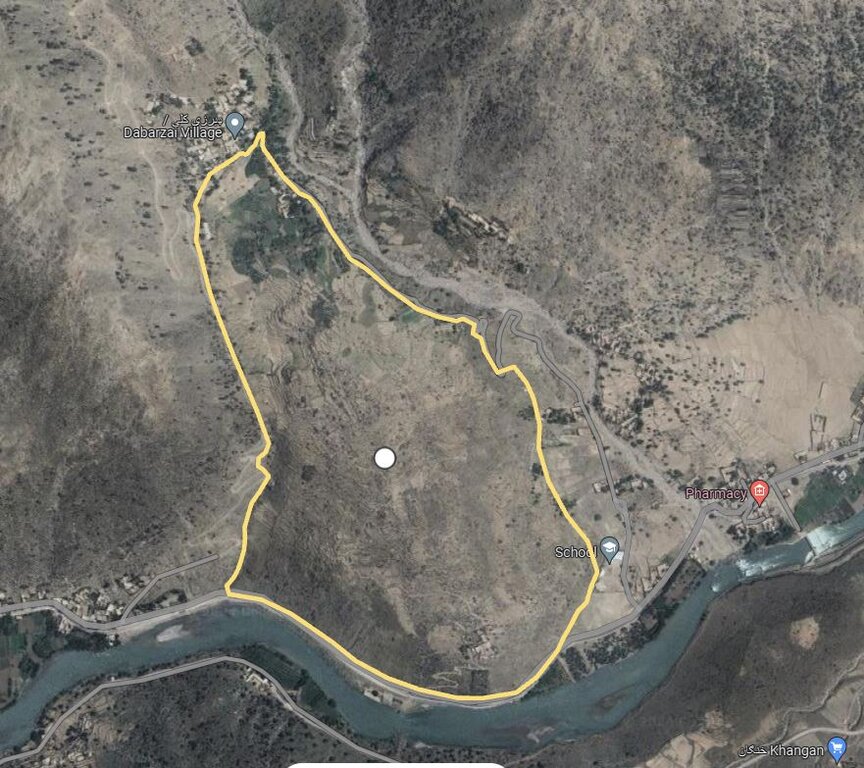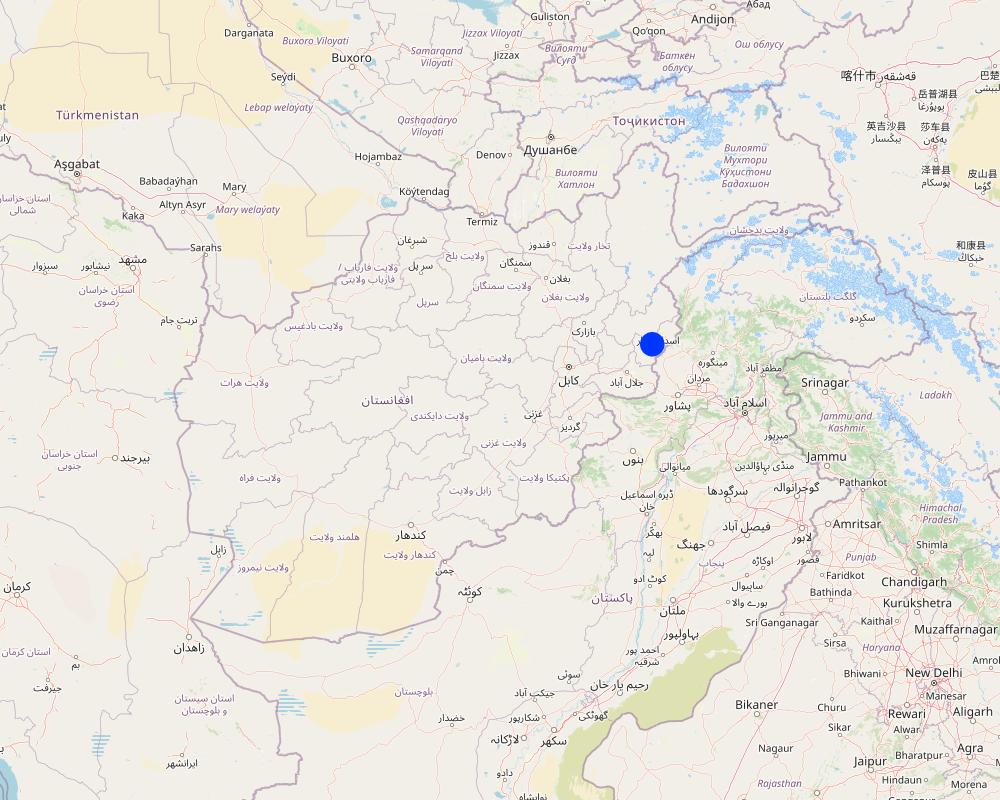Using lift irrigation for afforestation and agroforestry in Kunar [Afghanistan]
- Creation:
- Update:
- Compiler: Ahmad Khalid Wiyar
- Editors: Megha bajaj, Mohammad Ajmal Rahimy, Mir Wali Khan Lakanwal
- Reviewers: Rima Mekdaschi Studer, Illias Animon, Muhammad Ishaq Safi
د ځنګل رغونی او کرنیزی ځنګلداری لپاره د پمپ په واسطه د ابه خور سیستم
technologies_7473 - Afghanistan
- Full summary as PDF
- Full summary as PDF for print
- Full summary in the browser
- Full summary (unformatted)
- Using lift irrigation for afforestation and agroforestry in Kunar: March 5, 2025 (inactive)
- Using lift irrigation for afforestation and agroforestry in Kunar: March 24, 2025 (inactive)
- Using lift irrigation for afforestation and agroforestry in Kunar: May 18, 2025 (inactive)
- Using lift irrigation for afforestation and agroforestry in Kunar: July 9, 2025 (public)
View sections
Expand all Collapse all1. General information
1.2 Contact details of resource persons and institutions involved in the assessment and documentation of the Technology
Key resource person(s)
SLM specialist:
Safi Sharifullah
Food and Agriculture Organization of the United Nations
Afghanistan
land user:
Safi Mohammad Afzal
Managi Forest Management Association (FMA)
Afghanistan
land user:
Safi Qiamuddin
Managi Forest Management Association (FMA)
Afghanistan
land user:
Safi Farhad
Managi Forest Management Association (FMA)
Afghanistan
Name of project which facilitated the documentation/ evaluation of the Technology (if relevant)
Community-based sustainable land and forest management in AfghanistanName of the institution(s) which facilitated the documentation/ evaluation of the Technology (if relevant)
FAO Afghanistan (FAO Afghanistan) - Afghanistan1.3 Conditions regarding the use of data documented through WOCAT
The compiler and key resource person(s) accept the conditions regarding the use of data documented through WOCAT:
Yes
1.4 Declaration on sustainability of the described Technology
Is the Technology described here problematic with regard to land degradation, so that it cannot be declared a sustainable land management technology?
No
Comments:
No, the technology described here is not problematic with regard to land degradation. In fact, it promotes sustainable land management by enhancing soil health, preventing erosion, and supporting afforestation efforts. This technology contributes to the restoration and conservation of forest ecosystems.
2. Description of the SLM Technology
2.1 Short description of the Technology
Definition of the Technology:
Water exploitation is a major issue in Afghanistan. The lift irrigation technology helps to irrigate an afforestation/agroforestry area (demonstration plot) using surface water (rivers) and solar-powered submersible pump. The construction of reservoirs at the demo plot ensures efficient water storage and use for irrigation purposes without relying on groundwater. A well-designed pipe irrigation scheme is implemented to distribute water evenly across the site, supporting plant irrigation and growth.
2.2 Detailed description of the Technology
Description:
Water exploitation is a critical issue in Afghanistan, and the project aims to address this challenge through innovative and sustainable technology. The technology involves the use of solar panels and submersible water pumps to efficiently lift water from a nearby river to reservoirs constructed uphill, which is then distributed by gravity with the help of a pipe system to irrigate planted saplings in the afforested and agroforestry area. For afforestation, Pinus eldarica (Afghan pine) was planted due to its adaptability and soil stabilization properties. Additionally, citrus and persimmon trees are introduced for agroforestry, combining tree cultivation with agricultural benefits. This integrated technology promotes biodiversity, soil health, and sustainable land use, making the site a model/ demonstration site for afforestation and agroforestry practices. This is a significant advancement in the local area, utilizing clean energy to promote sustainable land and forest management and environmental restoration. The project is implemented on communal land, covering 50.25 hectares of land.
The primary purpose of this technology is to create an efficient irrigation system that extracts and transports water to support afforestation and agroforestry activities. By doing so, it aims to restore forest cover, mitigate environmental challenges such as land degradation, and promote long-term ecological and socio-economic sustainability. The technology includes key components such as solar panels, water pumps (submersible), polyvinyl chloride (PVC) pipes, water reservoirs, and saplings. Additionally, it requires labor, technical assistance, capacity-building programs, and construction materials for its establishment and maintenance.
The benefits of this technology are substantial. It has successfully irrigated previously barren land, achieving an impressive 85% survival rate for the saplings that were planted in the plot, while preventing land degradation and improving soil health. Without this technology, survival rates would drop to zero due to the arid conditions. Furthermore, the project has enhanced the capacities of local farmers/community members, enabling them to replicate and demonstrate the technology within their community. This has fostered a sense of ownership and empowerment among land users.
Land users have expressed both appreciation and concerns regarding the technology. On the positive side, they value its efficiency and reliability, as the solar panels provide a consistent water supply, especially during the hot/sunny season, leading to increased greenery and healthier trees. The cost-effectiveness of solar energy, with its low operational costs compared to traditional diesel pumps, has also been a significant advantage. Additionally, the environmentally friendly nature of the technology aligns with their desire for sustainable practices. The capacity-building programs provided by organizations like FAO have further empowered users to manage the system effectively.
However, some challenges have been noted. The initial investment costs for purchasing, installing and construction of the technology are high, making it difficult for smallholder farmers to replicate. Technical issues, such as inverter failures or battery malfunctions during extreme weather conditions (e.g., cloudy weather), can disrupt operations. Additionally, not all community members are equally informed about the technology’s benefits, highlighting the need for increased outreach and engagement efforts to ensure broader adoption and understanding.
In summary, this solar-powered irrigation technology represents a groundbreaking innovation in the area, combining clean energy with sustainable land management practices. While it has demonstrated significant environmental and agricultural benefits, addressing the challenges of initial costs, technical reliability, and community engagement will be crucial for its long-term success and scalability.
2.3 Photos of the Technology
2.4 Videos of the Technology
Location:
N/A
Name of videographer:
N/A
2.5 Country/ region/ locations where the Technology has been applied and which are covered by this assessment
Country:
Afghanistan
Region/ State/ Province:
Kunar
Further specification of location:
Managi village of Manogi district
Specify the spread of the Technology:
- applied at specific points/ concentrated on a small area
Is/are the technology site(s) located in a permanently protected area?
No
Comments:
The area is about 50.25 ha, and the coordinate has been taken from the center of the site, where technology has been implemented:
34.9419930°N71.0119714°E
Map
×2.6 Date of implementation
Indicate year of implementation:
2022
2.7 Introduction of the Technology
Specify how the Technology was introduced:
- through projects/ external interventions
Comments (type of project, etc.):
GEF-06 Community based Sustainable Land and Forest Management in Afghanistan
3. Classification of the SLM Technology
3.1 Main purpose(s) of the Technology
- improve production
- reduce, prevent, restore land degradation
- adapt to climate change/ extremes and its impacts
- create beneficial economic impact
3.2 Current land use type(s) where the Technology is applied
Land use mixed within the same land unit:
Yes
Specify mixed land use (crops/ grazing/ trees):
- Agroforestry

Cropland
- Tree and shrub cropping
Tree and shrub cropping - Specify crops:
- citrus
- Persimmon
Number of growing seasons per year:
- 1
Is intercropping practiced?
No
Is crop rotation practiced?
No

Forest/ woodlands
- Tree plantation, afforestation
Tree plantation, afforestation: Specify origin and composition of species:
- Monoculture local variety
Type of tree plantation, afforestation:
- subtropical dry forest plantation - Pinus spp.
Type of tree:
- Pinus species (pine)
Are the trees specified above deciduous or evergreen?
- evergreen
Products and services:
- Nature conservation/ protection
- Recreation/ tourism
- Protection against natural hazards
3.3 Has land use changed due to the implementation of the Technology?
Has land use changed due to the implementation of the Technology?
- Yes (Please fill out the questions below with regard to the land use before implementation of the Technology)
Land use mixed within the same land unit:
No
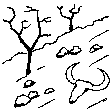
Unproductive land
Specify:
5 decades ago, the area was a forest area, but due to war, smuggling and drought the area become barren land.
3.4 Water supply
Water supply for the land on which the Technology is applied:
- mixed rainfed-irrigated
Comments:
The saplings planted in the area have been supplementary irrigated. Prior to the implementation of this technology, the land was barren, and seasonal rains led to soil erosion.
3.5 SLM group to which the Technology belongs
- forest plantation management
- improved ground/ vegetation cover
- energy efficiency technologies
3.6 SLM measures comprising the Technology

vegetative measures
- V1: Tree and shrub cover

structural measures
- S5: Dams, pans, ponds
- S7: Water harvesting/ supply/ irrigation equipment
- S10: Energy saving measures

management measures
- M1: Change of land use type
- M3: Layout according to natural and human environment
Comments:
The project has successfully implemented afforestation by planting trees and promoting agroforestry through the cultivation of fruit trees. To improve irrigation management, the project installed a 1-inch underground pipeline system with connected taps, enabling the attachment of flexible hoses. This efficient setup ensures optimal watering of saplings while significantly reducing water waste. By implementing this approach, the project has enhanced vegetative cover and successfully planted approximately 32,000 saplings. Additionally, the project constructed 14 rotating mounting structures for solar panels, installed 134 solar panels, established pipe schemes for manual irrigation of saplings, and constructed 6 water reservoirs with different capacities. The integration of trees at optimal spacing, combined with regular cultural practices, has further supported the project's goals.
3.7 Main types of land degradation addressed by the Technology

soil erosion by water
- Wt: loss of topsoil/ surface erosion

biological degradation
- Bc: reduction of vegetation cover
- Bh: loss of habitats
- Bl: loss of soil life

water degradation
- Ha: aridification
- Hg: change in groundwater/aquifer level
Comments:
The planting pits are specially designed for planting of saplings. Additionally, farmers construct small barriers near plants (eye-brows and trenches), known as micro-catchments, to collect and retain water. It is important to note that these micro-catchments are distinct structures, separate from pits and reservoirs, and are specifically built to support water retention for plants. The enhanced vegetation cover and the establishment of micro-catchments for water collection significantly reduce soil erosion. Soil improvement and enrichment, as well as habitat enhancement, are supported through these practices. Additionally, they contribute to groundwater recharge and help control runoff.
3.8 Prevention, reduction, or restoration of land degradation
Specify the goal of the Technology with regard to land degradation:
- prevent land degradation
- restore/ rehabilitate severely degraded land
Comments:
The human-induced causes of land degradation include deforestation, overgrazing of livestock, and unsustainable agricultural practices. In response, following the implementation of a specific technology, local communities established regulations rooted in their customs and traditions to protect the site, which is quarantined for five years. These regulations prohibit herders from grazing animals, cutting trees, engaging in unsustainable agricultural practices, and uprooting bushes for fuelwood. Additionally, the community has constructed rainwater harvesting structures, such as eyebrows and trenches, across the site to address natural causes of land degradation through runoff by enhancing water infiltration. As a result, the site is now effectively protected from both human-induced and natural land degradation.
4. Technical specifications, implementation activities, inputs, and costs
4.1 Technical drawing of the Technology
Technical specifications (related to technical drawing):
According to the technical specifications from the project engineer, 6 reservoirs have been constructed with varying dimensions and water holding capacities as follows:
1.First reservoir: Dimension of 12x6x2 meters, with a water holding capacity of 144 m³.
2.Central reservoir: Dimensions of 16x8x2 meters, with a water holding capacity of 256 m³.
3.Four additional reservoirs: Each measuring 10x5x2 meters, with a water holding capacity of 100 m³
In total, the reservoirs will hold 800 m³ of water, ensuring a reliable water supply for irrigation of the area. Two 2-inch submersible pumps draw water from the river to supply the first reservoir. From there, two additional 2-inch submersible pumps transfer water from the first reservoir to the central reservoir. The water then flows to the other four reservoirs by gravity.
Furthermore, excavation and backfilling for 2-inch polyethylene pipes should be done to a depth of 80 cm with a width of 50 cm. For 1.5-inch pipes, excavation and backfilling should be 40 cm deep. The installation of 1.5-inch polyethylene pipes, including all elbows, joints, connectors, and valves, should be carried out every 30 meters on both sides, connecting to 1-inch pipes, in accordance with specifications and to satisfaction.
Additionally, 32,000 Pinus eldarica (Afghan Pine) and 2,500 citrus and persimmon saplings were planted across 50.25 hectares of degraded land. The saplings are spaced 5 meters apart, both plant-to-plant and row-to-row, as part of afforestation and agroforestry initiatives. This effort aims to restore ecosystems, enhance biodiversity, and improve soil conservation.
Author:
Hafizullah Naeemy
Date:
01/03/2022
4.2 General information regarding the calculation of inputs and costs
Specify how costs and inputs were calculated:
- per Technology area
Indicate size and area unit:
50.25 Hectares
Specify currency used for cost calculations:
- USD
Indicate average wage cost of hired labour per day:
5 USD
4.3 Establishment activities
| Activity | Timing (season) | |
|---|---|---|
| 1. | Awareness and mobilization of the community | Aug-2021 |
| 2. | Survey and site selection followed by feasibility study | Sep to Oct-2021 |
| 3. | Stakeholder consultation | Aug-2021 till Sep-2022 |
| 4. | Preparation of technical design, drawings, and Bill of Quantities (BoQ). | Nov to Dec-2021 |
| 5. | Initiation of procurement process for required tools and equipment | Jan to Feb-2022 |
| 6. | Excavation and construction of water reservoirs, setting up pipe system and installation of solar panels for irrigation. | Mar to Sep-2022 |
| 7. | Capacity building of the target communities | Aug- 2021 till date |
| 8. | Practical interventions: production or purchase of saplings, digging planting pits, transplatation and irrigation of saplings and establishment of micro-catchments | Feb to Mar-2023 |
Comments:
The awareness-raising session on Sustainable Land Management (SLM) and Sustainable Forest Management (SFM) was successfully held to improve understanding of land and forest management practices and conservation efforts. Community members were actively mobilized to support the project, aiding in the completion of construction and installation work.
4.4 Costs and inputs needed for establishment
| Specify input | Unit | Quantity | Costs per Unit | Total costs per input | % of costs borne by land users | |
|---|---|---|---|---|---|---|
| Labour | Unskilled labor for planting of saplings | Man/day | 450.0 | 5.0 | 2250.0 | 100.0 |
| Labour | Skilled labor for installation of irrigation system and constuction of reservoirs | Man/day | 50.0 | 10.0 | 500.0 | |
| Equipment | Water Pump 2 inch - 10HP/7500w | Number | 4.0 | 450.0 | 1800.0 | |
| Equipment | Solar Panel minimum size 400W and 270W | Number | 132.0 | 82.0 | 10824.0 | |
| Equipment | DC to AC Inverter 7.5-11KW | Number | 4.0 | 450.0 | 1800.0 | |
| Equipment | Polyethylene Pipes 2 Inch and 1.5 Inch with all elbows, joints, connectors and valves after 30 meter for both sides to connect pipes. | Meter | 4300.0 | 2.75 | 11825.0 | |
| Equipment | Rotating PV panels mounting structure (manual) | Number | 28.0 | 270.0 | 7560.0 | |
| Equipment | DC and AC current wire | Meter | 1800.0 | 2.5 | 4500.0 | |
| Equipment | Distribution board | Number | 2.0 | 70.0 | 140.0 | |
| Equipment | Flexon 1 inch rubberize pipes | Meter | 5500.0 | 1.4 | 7700.0 | |
| Plant material | Saplings procured & transported | Sapling | 32000.0 | 0.775 | 24800.0 | |
| Plant material | Planting tools | lump sum | 1.0 | 500.0 | 500.0 | 100.0 |
| Fertilizers and biocides | Organic fertilizers for transplanted saplings added through community | Kg | 16000.0 | 0.1 | 1600.0 | 100.0 |
| Construction material | 6 reservoirs constructed by a construction company (cement, stone, sand excavation, etc.. | lump sum | 1.0 | 35000.0 | 35000.0 | |
| Other | Patrolling, irrigating and quarantine of the site | lump sum | 1.0 | 1000.0 | 1000.0 | 100.0 |
| Total costs for establishment of the Technology | 111799.0 | |||||
| Total costs for establishment of the Technology in USD | 111799.0 | |||||
If land user bore less than 100% of costs, indicate who covered the remaining costs:
The remining cost were covered by the project.
Comments:
The first two 2-inch submersible pumps draw water from the river to supply the first reservoir. From there, two additional 2-inch submersible pumps transfer water from the first reservoir to the central reservoir. The water then flows to the other four reservoirs through gravity.
4.5 Maintenance/ recurrent activities
| Activity | Timing/ frequency | |
|---|---|---|
| 1. | Cleaning of sedimentation of reservoirs | Spring/annually |
| 2. | Patrolling | All seasons/regular |
| 3. | Repairing solar system & water pump (submersible) | Ad hoc /Annually |
| 4. | Plot maintenance (Pest-diseases control, mulching, weeding,). | Spring & Automn/annually |
| 5. | Replacement of failed saplings | Feb/two times (1st & 2nd year) |
| 6. | Repairing micro-catchments | Spring/annually |
4.6 Costs and inputs needed for maintenance/ recurrent activities (per year)
| Specify input | Unit | Quantity | Costs per Unit | Total costs per input | % of costs borne by land users | |
|---|---|---|---|---|---|---|
| Labour | Labor for cleaning of sedimentation of reservoirs | Man/day | 60.0 | 5.0 | 300.0 | 100.0 |
| Labour | Labor for patrolling | Man/day | 360.0 | 5.0 | 1800.0 | 100.0 |
| Labour | Labor for repairing micro-catchments | Man/day | 20.0 | 5.0 | 100.0 | 100.0 |
| Labour | Manage the solar system operations | Man/day | 360.0 | 2.77 | 997.2 | 100.0 |
| Labour | Labor for weeding and mulching | Man/day | 30.0 | 5.0 | 150.0 | 100.0 |
| Equipment | Pump submersible, PVC pipe, fittings | lumpsum | 3.0 | 500.0 | 1500.0 | 100.0 |
| Equipment | Shovels | lumpsum | 1.0 | 140.0 | 140.0 | 100.0 |
| Plant material | saplings | Sapling | 2000.0 | 0.6 | 1200.0 | 100.0 |
| Fertilizers and biocides | Organic fertilizers (cows dungs) | Kg | 16000.0 | 0.1 | 1600.0 | 100.0 |
| Total costs for maintenance of the Technology | 7787.2 | |||||
| Total costs for maintenance of the Technology in USD | 7787.2 | |||||
Comments:
The community has hired an individual to manage the solar system operations. This person is responsible for both operating the solar system for lifting water and overseeing the distribution of water for irrigation purposes among community members.
4.7 Most important factors affecting the costs
Describe the most determinate factors affecting the costs:
All equipment are imported and has resulted into higher cost.
Natural hazards, floods and windstorms will increase the costs of repairs and replacement
5. Natural and human environment
5.1 Climate
Annual rainfall
- < 250 mm
- 251-500 mm
- 501-750 mm
- 751-1,000 mm
- 1,001-1,500 mm
- 1,501-2,000 mm
- 2,001-3,000 mm
- 3,001-4,000 mm
- > 4,000 mm
Specify average annual rainfall (if known), in mm:
300.00
Specifications/ comments on rainfall:
Most of rain occur in the months of Feb, Mar, Apr, July and Aug.
Indicate the name of the reference meteorological station considered:
The data has been collected based on the farmers observation and local practices.
Agro-climatic zone
- semi-arid
5.2 Topography
Slopes on average:
- flat (0-2%)
- gentle (3-5%)
- moderate (6-10%)
- rolling (11-15%)
- hilly (16-30%)
- steep (31-60%)
- very steep (>60%)
Landforms:
- plateau/plains
- ridges
- mountain slopes
- hill slopes
- footslopes
- valley floors
Altitudinal zone:
- 0-100 m a.s.l.
- 101-500 m a.s.l.
- 501-1,000 m a.s.l.
- 1,001-1,500 m a.s.l.
- 1,501-2,000 m a.s.l.
- 2,001-2,500 m a.s.l.
- 2,501-3,000 m a.s.l.
- 3,001-4,000 m a.s.l.
- > 4,000 m a.s.l.
Indicate if the Technology is specifically applied in:
- concave situations
5.3 Soils
Soil depth on average:
- very shallow (0-20 cm)
- shallow (21-50 cm)
- moderately deep (51-80 cm)
- deep (81-120 cm)
- very deep (> 120 cm)
Soil texture (topsoil):
- medium (loamy, silty)
Soil texture (> 20 cm below surface):
- medium (loamy, silty)
Topsoil organic matter:
- low (<1%)
5.4 Water availability and quality
Ground water table:
> 50 m
Availability of surface water:
medium
Water quality (untreated):
good drinking water
Water quality refers to:
both ground and surface water
Is water salinity a problem?
No
Is flooding of the area occurring?
Yes
Regularity:
frequently
5.5 Biodiversity
Species diversity:
- medium
Habitat diversity:
- medium
5.6 Characteristics of land users applying the Technology
Sedentary or nomadic:
- Sedentary
Market orientation of production system:
- mixed (subsistence/ commercial)
Off-farm income:
- less than 10% of all income
Relative level of wealth:
- poor
Individuals or groups:
- groups/ community
Level of mechanization:
- manual work
Gender:
- men
Age of land users:
- middle-aged
5.7 Average area of land used by land users applying the Technology
- < 0.5 ha
- 0.5-1 ha
- 1-2 ha
- 2-5 ha
- 5-15 ha
- 15-50 ha
- 50-100 ha
- 100-500 ha
- 500-1,000 ha
- 1,000-10,000 ha
- > 10,000 ha
Is this considered small-, medium- or large-scale (referring to local context)?
- small-scale
Comments:
The area where the technology is applied covers 50.25 hectares and is managed by 112 land users.
5.8 Land ownership, land use rights, and water use rights
Land ownership:
- communal/ village
- individual, titled
Land use rights:
- communal (organized)
- individual
Water use rights:
- communal (organized)
- individual
Are land use rights based on a traditional legal system?
Yes
Specify:
In Afghanistan, the traditional land use system involves the equitable distribution of deserts and barren land among the local residents. The decisions made by the elders are respected and adhered to by all members of the community.
5.9 Access to services and infrastructure
health:
- poor
- moderate
- good
education:
- poor
- moderate
- good
technical assistance:
- poor
- moderate
- good
employment (e.g. off-farm):
- poor
- moderate
- good
markets:
- poor
- moderate
- good
energy:
- poor
- moderate
- good
roads and transport:
- poor
- moderate
- good
drinking water and sanitation:
- poor
- moderate
- good
financial services:
- poor
- moderate
- good
6. Impacts and concluding statements
6.1 On-site impacts the Technology has shown
Socio-economic impacts
Production
crop production
Quantity before SLM:
0
Quantity after SLM:
fruit production (citrus and persimmon)
Comments/ specify:
The 2500 citrus and persimmon saplings have been planted as part of the agroforestry system and will bear fruit in line with the demand and needs of the people. Based on the production, the socio-economic status of the community members is expected to improve.
wood production
Quantity before SLM:
0
Quantity after SLM:
A total of 32,000 forest saplings (Pinus species) were successfully planted
Comments/ specify:
32,000 Pinus eldarica (Afghani pine) and 2,500 citrus and persimmon saplings have been planted across 50.25 hectares of degraded land. Following agronomic practices, the four Ds—dead, diseased, damaged, and dying—branches will be pruned and utilized for shelter and fuel.
production area
Quantity before SLM:
0 fruit trees
Quantity after SLM:
Approximately 1,200 fruit trees, including sweet orange and persimmon species, have been planted
Comments/ specify:
The 2500 citrus and persimmon saplings have been planted as a agroforestry and will bear fruit in line with the demand and needs of the people.
land management
Comments/ specify:
The area was once barren and occasionally used for rainfed cultivation, where most farmers grew wheat. Now, with the introduction and implementation of the technology farmers can also intercrop beans, mung beans, and others. Farmers who have more than 1 hectare of land hire labor for agronomical practices.
Water availability and quality
irrigation water availability
Quantity before SLM:
0
Quantity after SLM:
100%
Comments/ specify:
With the adoption of this technology, irrigation for planted saplings is now available 100% throughout all seasons of the year.
Income and costs
diversity of income sources
Comments/ specify:
Timber Production, Non-Timber Forest Products, Ecotourism, Agroforestry, Wildlife Conservation and Fuelwood and Biomass
Socio-cultural impacts
recreational opportunities
Comments/ specify:
Recreational opportunities that benefit both local communities and visitors such as nature trails allowed individuals to engage with nature, promoting physical activity and wellness. The reforestation efforts have led to the restoration of habitats for various wildlife species, this provides opportunities for wildlife observation and photography, and contributing to local ecotourism.
SLM/ land degradation knowledge
Comments/ specify:
Improved due to workshops and on job trainings
Ecological impacts
Water cycle/ runoff
surface runoff
Comments/ specify:
Due to better soil coverage by plantation of saplings and micro-catchment structures
Soil
soil moisture
Comments/ specify:
Due to the availability of irrigation water and the establishment of micro-catchments to harvest water and enhance water infiltaration soil moisture for sapling growth has increased
soil cover
Comments/ specify:
Due to natural regeneration and plantation of saplings and intercrops
soil loss
Comments/ specify:
Due to better soil coverage and less water runoff
Biodiversity: vegetation, animals
Vegetation cover
biomass/ above ground C
plant diversity
Climate and disaster risk reduction
flood impacts
Comments/ specify:
better soil cover reduced water runoff and ultimately flooding
6.2 Off-site impacts the Technology has shown
damage on public/ private infrastructure
Comments/ specify:
Soil erosion was reduced and has been better controlled
impact of greenhouse gases
Comments/ specify:
Due to plantation
6.3 Exposure and sensitivity of the Technology to gradual climate change and climate-related extremes/ disasters (as perceived by land users)
Gradual climate change
Gradual climate change
| Season | increase or decrease | How does the Technology cope with it? | |
|---|---|---|---|
| annual temperature | increase | moderately | |
| annual rainfall | increase | moderately | |
| seasonal rainfall | spring | increase | moderately |
Climate-related extremes (disasters)
Meteorological disasters
| How does the Technology cope with it? | |
|---|---|
| local windstorm | moderately |
6.4 Cost-benefit analysis
How do the benefits compare with the establishment costs (from land users’ perspective)?
Short-term returns:
slightly positive
Long-term returns:
very positive
How do the benefits compare with the maintenance/ recurrent costs (from land users' perspective)?
Short-term returns:
slightly positive
Long-term returns:
very positive
6.5 Adoption of the Technology
- 1-10%
Of all those who have adopted the Technology, how many did so spontaneously, i.e. without receiving any material incentives/ payments?
- 0-10%
Comments:
The community economic condition is not good. So, without receiving incentives they are not able to adopt such technology easily.
6.6 Adaptation
Has the Technology been modified recently to adapt to changing conditions?
No
6.7 Strengths/ advantages/ opportunities of the Technology
| Strengths/ advantages/ opportunities in the land user’s view |
|---|
| Improved water availability with minimized fuel cost and decreased pollution as well as minimum operational cost |
| Opportunities/ potential for upscaling of the technology |
| Use of clean energy to contribute to mitigate climate change |
| Reduce greenhouse emission through carbon sequestration |
| Strengths/ advantages/ opportunities in the compiler’s or other key resource person’s view |
|---|
| The technology is highly efficient and suitable for adoption by land users. It promotes clean energy, reduces greenhouse gas emissions through carbon sequestration, and contributes to climate change adaptation. |
| The area has been successfully afforested, restoring its natural beauty and original landscape. |
| The vegetation cover on the previously degraded land has been significantly enhanced. |
| This technology with its approach for implementation represents an effective solution for the restoration of degraded soils. |
6.8 Weaknesses/ disadvantages/ risks of the Technology and ways of overcoming them
| Weaknesses/ disadvantages/ risks in the land user’s view | How can they be overcome? |
|---|---|
| Inadequate maintenance and repair services of the technology | Linkage to the service provider and maintenance services. Nation wide technology transfer |
| Solar water lifting relies on fully sunny days for operation, which can sometimes be a limitation, especially when weather conditions are cloudy or during periods of low sunlight. This can result in insufficient water being lifted to meet the irrigation needs of the site. | Backup charging system/battery system |
| Weaknesses/ disadvantages/ risks in the compiler’s or other key resource person’s view | How can they be overcome? |
|---|---|
| Solar water lifting depends on sunny days for operation, which can sometimes fall short of meeting irrigation needs during cloudy periods. | Combining solar power with backup energy (like batteries or grid connection) |
7. References and links
7.1 Methods/ sources of information
- field visits, field surveys
10
- interviews with land users
15
- interviews with SLM specialists/ experts
2
When were the data compiled (in the field)?
28/11/2024
Comments:
The data has been collected during Oct and Nov 2024
Links and modules
Expand all Collapse allLinks
No links
Modules
No modules


